Abstract
Phage T7 DNA polymerase consists of a 1:1 complex of the viral T7 gene 5 protein and the host cell thioredoxin. A 3.25-kilobase T7 DNA fragment containing the complete coding sequence of gene 5, and the nearby genes 4.7 and 5.3, was cloned in the BamHI site of the plasmid pBR322. Transformation of the thioredoxin-negative (trxA-) Escherichia coli strain BH215 with the recombinant plasmid pRS101 resulted in large overproduction of gene 5 protein corresponding to a level about 60-fold higher than in T7-infected cells. Transcription of gene 5 probably originates from a previously unknown E. coli RNA polymerase promoter located immediately upstream of the structural gene. Contrary to expectation, pRS101 could be maintained also in E. coli trxA+ cells despite the in vivo formation of active T7 DNA polymerase. However, the expression of gene 5 was lower by a factor of 5-10 than in trxA- cells. Since the plasmid copy number in the two strains was the same, a gene dosage effect can be excluded. The observed difference suggests an autoregulatory interaction of T7 DNA polymerase holoenzyme on the expression of T7 gene 5. The trxA- strain BH215/pRS101 is an excellent source of gene 5 protein and T7 DNA polymerase. After in vitro reconstitution of holoenzyme by addition of excess thioredoxin, highly active T7 DNA polymerase was purified to homogeneity by a simple antithioredoxin immunoadsorbent chromatography technique.
Full text
PDF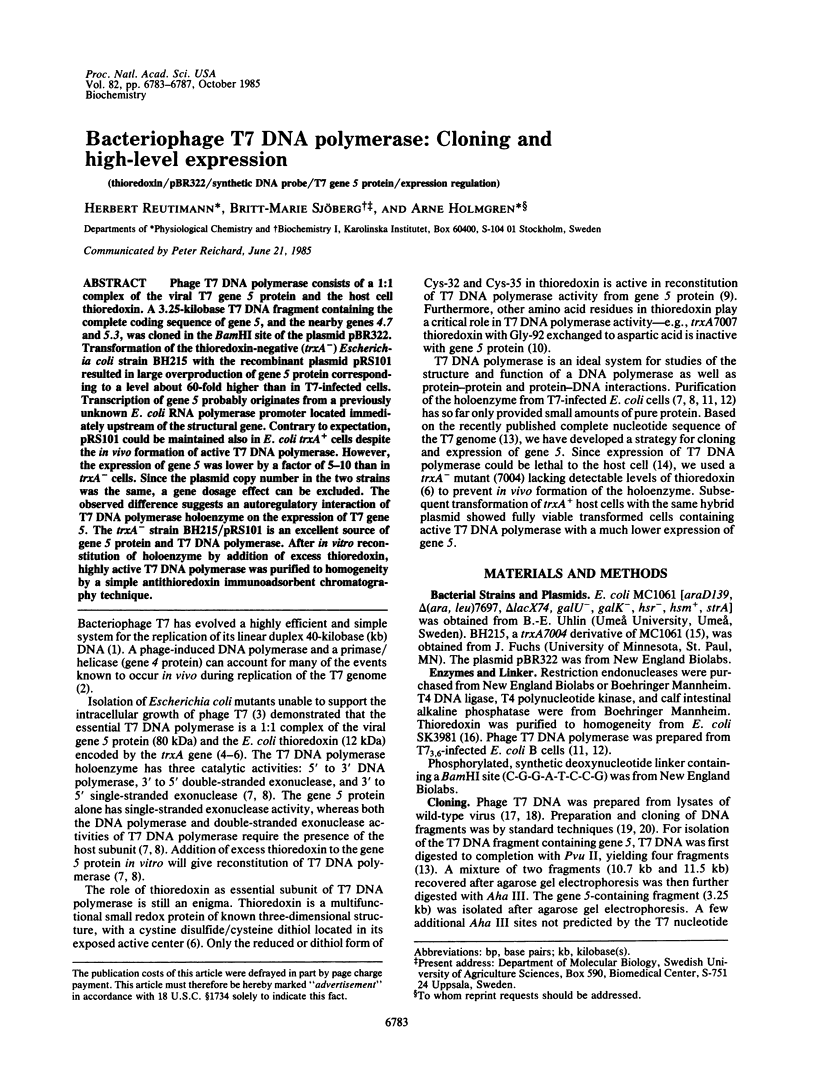
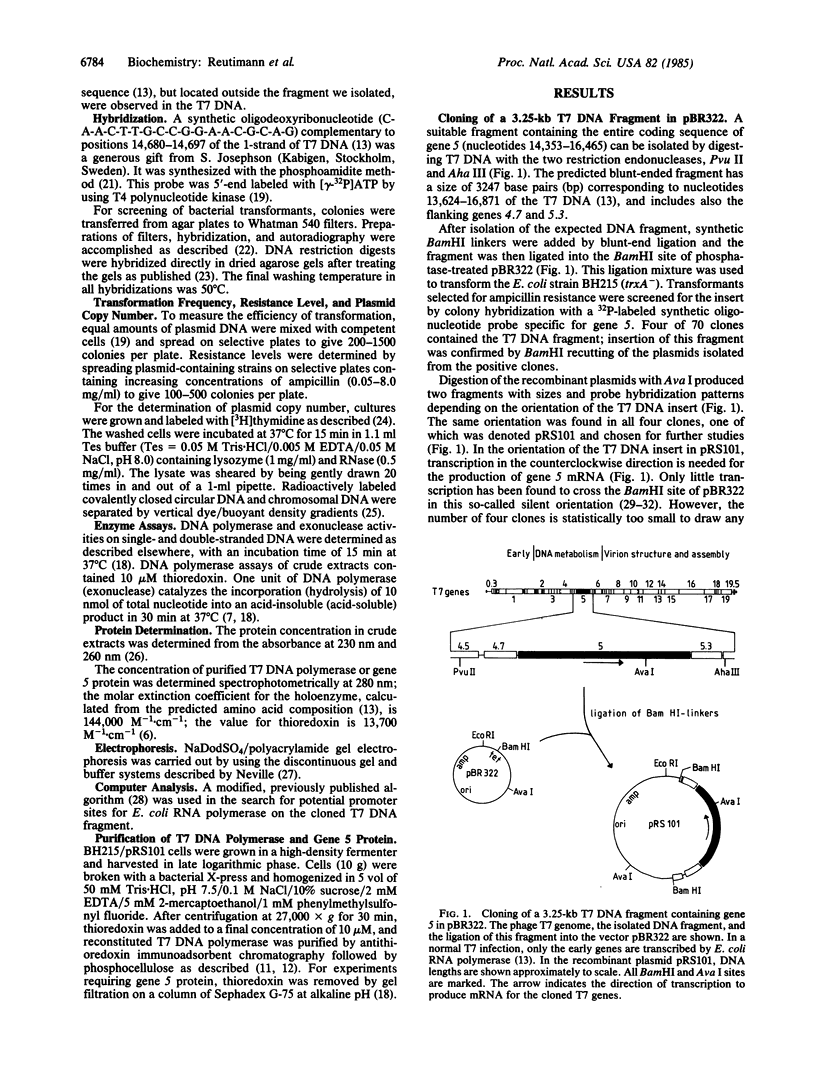
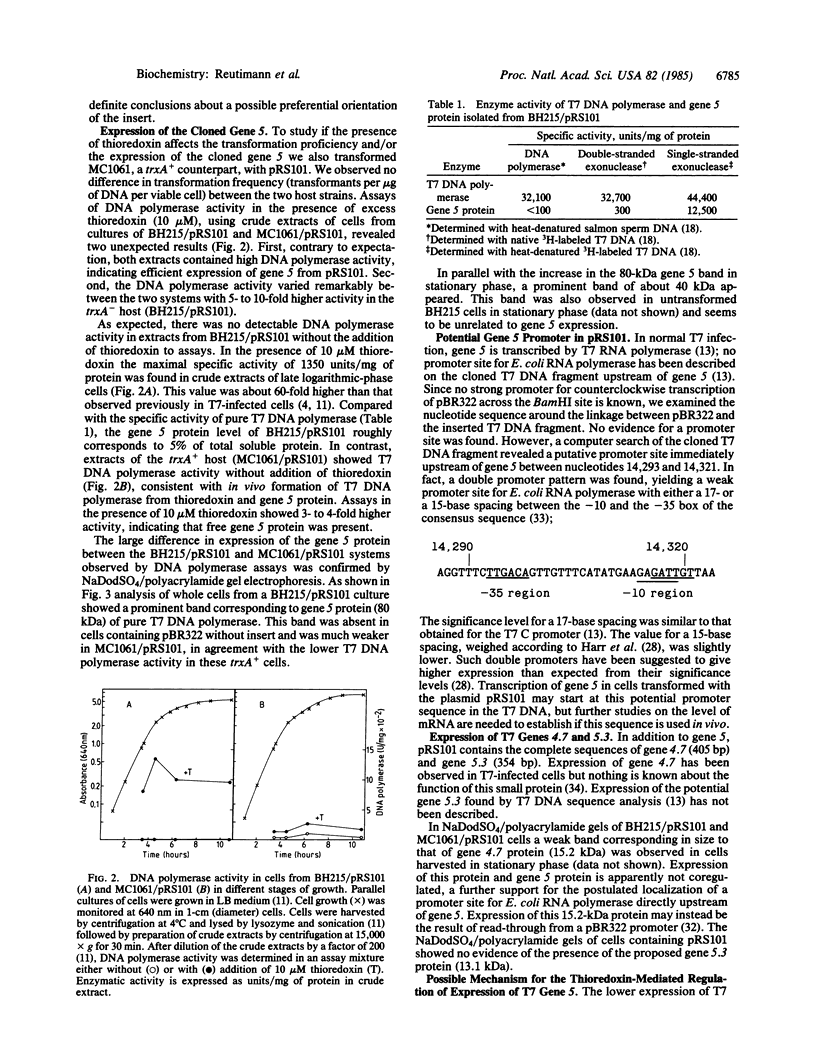
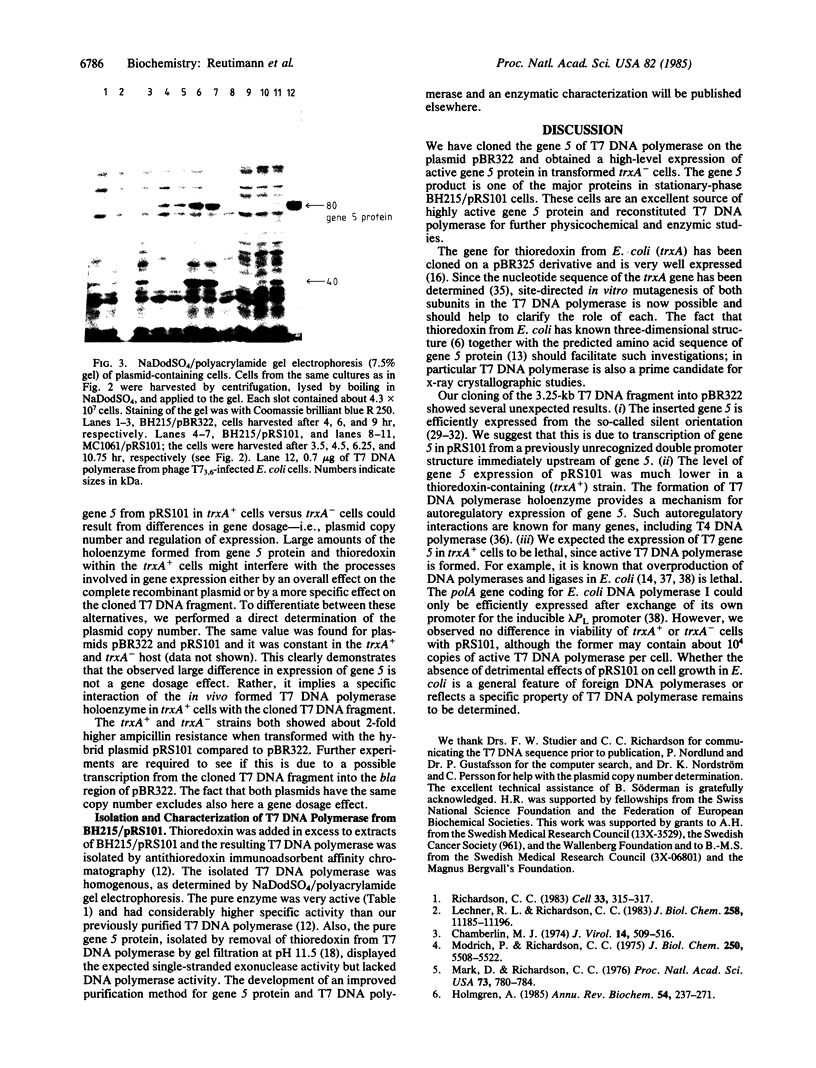
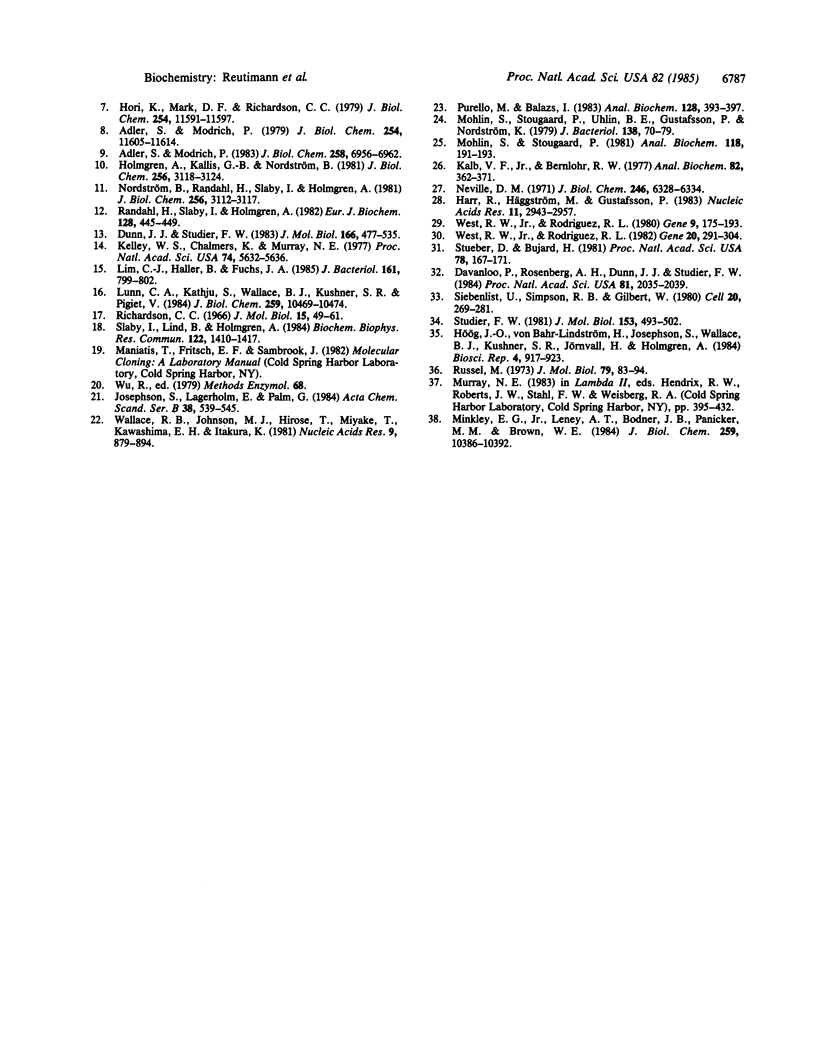
Images in this article
Selected References
These references are in PubMed. This may not be the complete list of references from this article.
- Adler S., Modrich P. T7-induced DNA polymerase. Characterization of associated exonuclease activities and resolution into biologically active subunits. J Biol Chem. 1979 Nov 25;254(22):11605–11614. [PubMed] [Google Scholar]
- Adler S., Modrich P. T7-induced DNA polymerase. Requirement for thioredoxin sulfhydryl groups. J Biol Chem. 1983 Jun 10;258(11):6956–6962. [PubMed] [Google Scholar]
- Chamberlin M. Isolation and characterization of prototrophic mutants of Escherichia coli unable to support the intracellular growth of T7. J Virol. 1974 Sep;14(3):509–516. doi: 10.1128/jvi.14.3.509-516.1974. [DOI] [PMC free article] [PubMed] [Google Scholar]
- Davanloo P., Rosenberg A. H., Dunn J. J., Studier F. W. Cloning and expression of the gene for bacteriophage T7 RNA polymerase. Proc Natl Acad Sci U S A. 1984 Apr;81(7):2035–2039. doi: 10.1073/pnas.81.7.2035. [DOI] [PMC free article] [PubMed] [Google Scholar]
- Dunn J. J., Studier F. W. Complete nucleotide sequence of bacteriophage T7 DNA and the locations of T7 genetic elements. J Mol Biol. 1983 Jun 5;166(4):477–535. doi: 10.1016/s0022-2836(83)80282-4. [DOI] [PubMed] [Google Scholar]
- Harr R., Häggström M., Gustafsson P. Search algorithm for pattern match analysis of nucleic acid sequences. Nucleic Acids Res. 1983 May 11;11(9):2943–2957. doi: 10.1093/nar/11.9.2943. [DOI] [PMC free article] [PubMed] [Google Scholar]
- Holmgren A., Kallis G. B., Nordström B. A mutant thioredoxin from Escherichia coli tsnC 7007 that is nonfunctional as subunit of phage T7 DNA polymerase. J Biol Chem. 1981 Mar 25;256(6):3118–3124. [PubMed] [Google Scholar]
- Holmgren A. Thioredoxin. Annu Rev Biochem. 1985;54:237–271. doi: 10.1146/annurev.bi.54.070185.001321. [DOI] [PubMed] [Google Scholar]
- Hori K., Mark D. F., Richardson C. C. Deoxyribonucleic acid polymerase of bacteriophage T7. Purification and properties of the phage-encoded subunit, the gene 5 protein. J Biol Chem. 1979 Nov 25;254(22):11591–11597. [PubMed] [Google Scholar]
- Hög J. O., von Bahr-Lindström H., Josephson S., Wallace B. J., Kushner S. R., Jörnvall H., Holmgren A. Nucleotide sequence of the thioredoxin gene from Escherichia coli. Biosci Rep. 1984 Nov;4(11):917–923. doi: 10.1007/BF01116889. [DOI] [PubMed] [Google Scholar]
- Josephson S., Lagerholm E., Palm G. Automatic synthesis of oligodeoxynucleotides and mixed oligodeoxynucleotides using the phosphoamidite method. Acta Chem Scand B. 1984;38(7):539–545. doi: 10.3891/acta.chem.scand.38b-0539. [DOI] [PubMed] [Google Scholar]
- Kalb V. F., Jr, Bernlohr R. W. A new spectrophotometric assay for protein in cell extracts. Anal Biochem. 1977 Oct;82(2):362–371. doi: 10.1016/0003-2697(77)90173-7. [DOI] [PubMed] [Google Scholar]
- Kelley W. S., Chalmers K., Murray N. E. Isolation and characterization of a lambdapolA transducing phage. Proc Natl Acad Sci U S A. 1977 Dec;74(12):5632–5636. doi: 10.1073/pnas.74.12.5632. [DOI] [PMC free article] [PubMed] [Google Scholar]
- Lim C. J., Haller B., Fuchs J. A. Thioredoxin is the bacterial protein encoded by fip that is required for filamentous bacteriophage f1 assembly. J Bacteriol. 1985 Feb;161(2):799–802. doi: 10.1128/jb.161.2.799-802.1985. [DOI] [PMC free article] [PubMed] [Google Scholar]
- Lunn C. A., Kathju S., Wallace B. J., Kushner S. R., Pigiet V. Amplification and purification of plasmid-encoded thioredoxin from Escherichia coli K12. J Biol Chem. 1984 Aug 25;259(16):10469–10474. [PubMed] [Google Scholar]
- Mark D. F., Richardson C. C. Escherichia coli thioredoxin: a subunit of bacteriophage T7 DNA polymerase. Proc Natl Acad Sci U S A. 1976 Mar;73(3):780–784. doi: 10.1073/pnas.73.3.780. [DOI] [PMC free article] [PubMed] [Google Scholar]
- Minkley E. G., Jr, Leney A. T., Bodner J. B., Panicker M. M., Brown W. E. Escherichia coli DNA polymerase I. Construction of a polA plasmid for amplification and an improved purification scheme. J Biol Chem. 1984 Aug 25;259(16):10386–10392. [PubMed] [Google Scholar]
- Modrich P., Richardson C. C. Bacteriophage T7 Deoxyribonucleic acid replication in vitro. A protein of Escherichia coli required for bacteriophage T7 DNA polymerase activity. J Biol Chem. 1975 Jul 25;250(14):5508–5514. [PubMed] [Google Scholar]
- Molin S., Stougaard P., Uhlin B. E., Gustafsson P., Nordström K. Clustering of genes involved in replication, copy number control, incompatibility, and stable maintenance of the resistance plasmid R1drd-19. J Bacteriol. 1979 Apr;138(1):70–79. doi: 10.1128/jb.138.1.70-79.1979. [DOI] [PMC free article] [PubMed] [Google Scholar]
- Neville D. M., Jr Molecular weight determination of protein-dodecyl sulfate complexes by gel electrophoresis in a discontinuous buffer system. J Biol Chem. 1971 Oct 25;246(20):6328–6334. [PubMed] [Google Scholar]
- Nordström B., Randahl H., Slaby I., Holmgren A. Characterization of bacteriophage T7 DNA polymerase purified to homogeneity by antithioredoxin immunoadsorbent chromatography. J Biol Chem. 1981 Mar 25;256(6):3112–3117. [PubMed] [Google Scholar]
- Purrello M., Balazs I. Direct hybridization of labeled DNA to DNA in agarose gels. Anal Biochem. 1983 Feb 1;128(2):393–397. doi: 10.1016/0003-2697(83)90391-3. [DOI] [PubMed] [Google Scholar]
- Randahl H., Slabý I., Holmgren A. An improved purification method and a physical characterization of phage T7 DNA polymerase. Eur J Biochem. 1982 Nov 15;128(2-3):445–449. doi: 10.1111/j.1432-1033.1982.tb06984.x. [DOI] [PubMed] [Google Scholar]
- Richardson C. C. Bacteriophage T7: minimal requirements for the replication of a duplex DNA molecule. Cell. 1983 Jun;33(2):315–317. doi: 10.1016/0092-8674(83)90411-7. [DOI] [PubMed] [Google Scholar]
- Richardson C. C. The 5'-terminal nucleotides of T7 bacteriophage deoxyribonucleic acid. J Mol Biol. 1966 Jan;15(1):49–61. doi: 10.1016/s0022-2836(66)80208-5. [DOI] [PubMed] [Google Scholar]
- Russel M. Control of bacteriophage T4 DNA polymerase synthesis. J Mol Biol. 1973 Sep 5;79(1):83–94. doi: 10.1016/0022-2836(73)90271-4. [DOI] [PubMed] [Google Scholar]
- Siebenlist U., Simpson R. B., Gilbert W. E. coli RNA polymerase interacts homologously with two different promoters. Cell. 1980 Jun;20(2):269–281. doi: 10.1016/0092-8674(80)90613-3. [DOI] [PubMed] [Google Scholar]
- Slaby I., Lind B., Holmgren A. T7 DNA polymerase is not a zinc-metalloenzyme and the polymerase and exonuclease activities are inhibited by zinc ions. Biochem Biophys Res Commun. 1984 Aug 16;122(3):1410–1417. doi: 10.1016/0006-291x(84)91248-8. [DOI] [PubMed] [Google Scholar]
- Stougaard P., Molin S. Vertical dye-buoyant density gradients for rapid analysis and preparation of plasmid DNA. Anal Biochem. 1981 Nov 15;118(1):191–193. doi: 10.1016/0003-2697(81)90177-9. [DOI] [PubMed] [Google Scholar]
- Studier F. W. Identification and mapping of five new genes in bacteriophage T7. J Mol Biol. 1981 Dec 15;153(3):493–502. doi: 10.1016/0022-2836(81)90404-6. [DOI] [PubMed] [Google Scholar]
- Stüber D., Bujard H. Organization of transcriptional signals in plasmids pBR322 and pACYC184. Proc Natl Acad Sci U S A. 1981 Jan;78(1):167–171. doi: 10.1073/pnas.78.1.167. [DOI] [PMC free article] [PubMed] [Google Scholar]
- Wallace R. B., Johnson M. J., Hirose T., Miyake T., Kawashima E. H., Itakura K. The use of synthetic oligonucleotides as hybridization probes. II. Hybridization of oligonucleotides of mixed sequence to rabbit beta-globin DNA. Nucleic Acids Res. 1981 Feb 25;9(4):879–894. doi: 10.1093/nar/9.4.879. [DOI] [PMC free article] [PubMed] [Google Scholar]
- West R. W., Jr, Rodriguez R. L. Construction and characterization of E. coli promoter-probe plasmid vectors. II. RNA polymerase binding studies on antibiotic-resistance promoters. Gene. 1980 May;9(3-4):175–193. doi: 10.1016/0378-1119(90)90321-h. [DOI] [PubMed] [Google Scholar]
- West R. W., Jr, Rodriguez R. L. Construction and characterization of E. coli promoter-probe plasmid vectors. III. pBR322 derivatives with deletions in the tetracycline resistance promoter region. Gene. 1982 Dec;20(2):291–304. doi: 10.1016/0378-1119(82)90047-6. [DOI] [PubMed] [Google Scholar]



